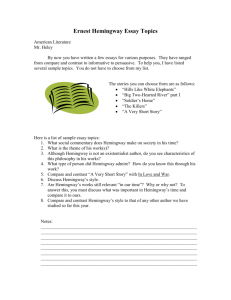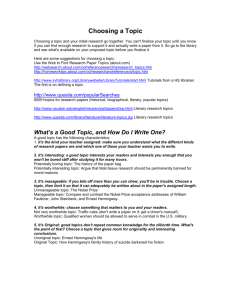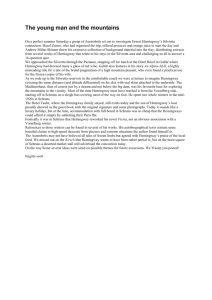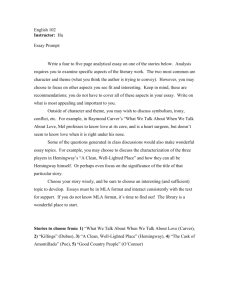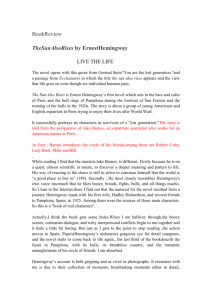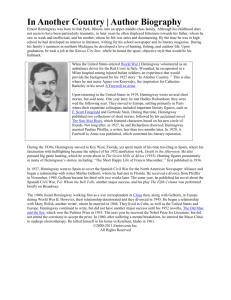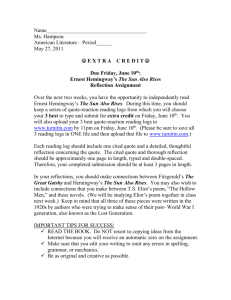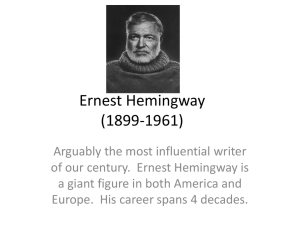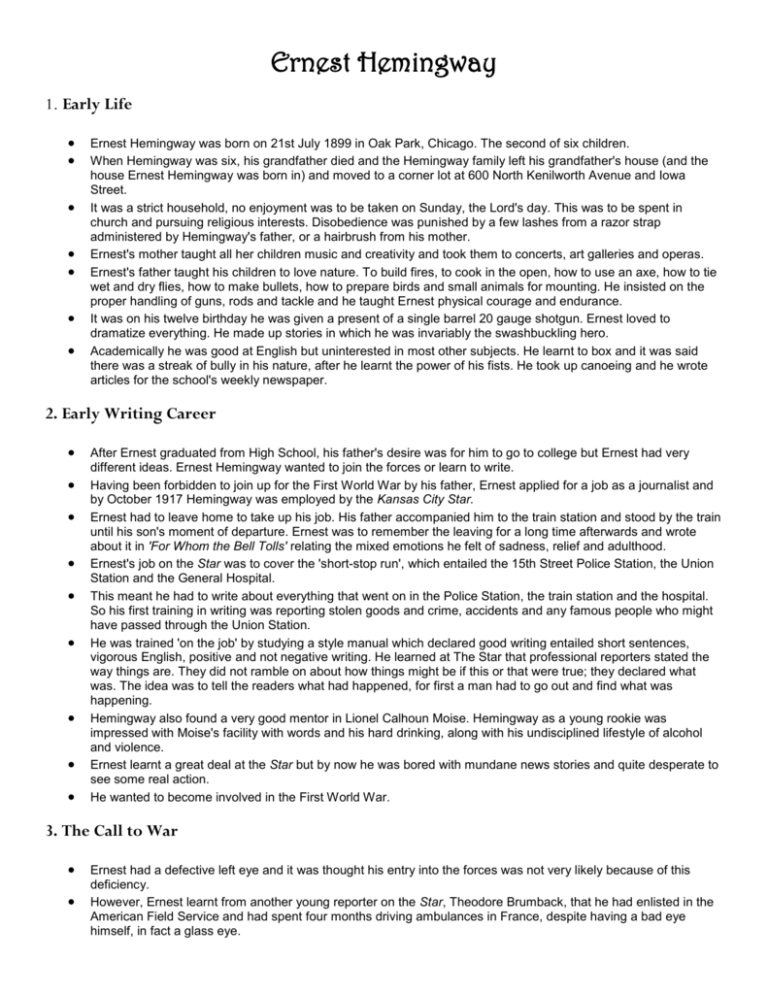
Ernest Hemingway
1. Early Life
Ernest Hemingway was born on 21st July 1899 in Oak Park, Chicago. The second of six children.
When Hemingway was six, his grandfather died and the Hemingway family left his grandfather's house (and the
house Ernest Hemingway was born in) and moved to a corner lot at 600 North Kenilworth Avenue and Iowa
Street.
It was a strict household, no enjoyment was to be taken on Sunday, the Lord's day. This was to be spent in
church and pursuing religious interests. Disobedience was punished by a few lashes from a razor strap
administered by Hemingway's father, or a hairbrush from his mother.
Ernest's mother taught all her children music and creativity and took them to concerts, art galleries and operas.
Ernest's father taught his children to love nature. To build fires, to cook in the open, how to use an axe, how to tie
wet and dry flies, how to make bullets, how to prepare birds and small animals for mounting. He insisted on the
proper handling of guns, rods and tackle and he taught Ernest physical courage and endurance.
It was on his twelve birthday he was given a present of a single barrel 20 gauge shotgun. Ernest loved to
dramatize everything. He made up stories in which he was invariably the swashbuckling hero.
Academically he was good at English but uninterested in most other subjects. He learnt to box and it was said
there was a streak of bully in his nature, after he learnt the power of his fists. He took up canoeing and he wrote
articles for the school's weekly newspaper.
2. Early Writing Career
After Ernest graduated from High School, his father's desire was for him to go to college but Ernest had very
different ideas. Ernest Hemingway wanted to join the forces or learn to write.
Having been forbidden to join up for the First World War by his father, Ernest applied for a job as a journalist and
by October 1917 Hemingway was employed by the Kansas City Star.
Ernest had to leave home to take up his job. His father accompanied him to the train station and stood by the train
until his son's moment of departure. Ernest was to remember the leaving for a long time afterwards and wrote
about it in 'For Whom the Bell Tolls' relating the mixed emotions he felt of sadness, relief and adulthood.
Ernest's job on the Star was to cover the 'short-stop run', which entailed the 15th Street Police Station, the Union
Station and the General Hospital.
This meant he had to write about everything that went on in the Police Station, the train station and the hospital.
So his first training in writing was reporting stolen goods and crime, accidents and any famous people who might
have passed through the Union Station.
He was trained 'on the job' by studying a style manual which declared good writing entailed short sentences,
vigorous English, positive and not negative writing. He learned at The Star that professional reporters stated the
way things are. They did not ramble on about how things might be if this or that were true; they declared what
was. The idea was to tell the readers what had happened, for first a man had to go out and find what was
happening.
Hemingway also found a very good mentor in Lionel Calhoun Moise. Hemingway as a young rookie was
impressed with Moise's facility with words and his hard drinking, along with his undisciplined lifestyle of alcohol
and violence.
Ernest learnt a great deal at the Star but by now he was bored with mundane news stories and quite desperate to
see some real action.
He wanted to become involved in the First World War.
3. The Call to War
Ernest had a defective left eye and it was thought his entry into the forces was not very likely because of this
deficiency.
However, Ernest learnt from another young reporter on the Star, Theodore Brumback, that he had enlisted in the
American Field Service and had spent four months driving ambulances in France, despite having a bad eye
himself, in fact a glass eye.
On Feb. 22, 1918 - The Star carried this headline: ``Red Cross Calls Men.'' Also needed, listed in fine print: ``Four
ambulance drivers for Italy.”
Some stories state that Hemingway saw this article before it was actually printed in the newspaper and got
accepted before over 200 other men applied for the position.
After only six months employment as a journalist, Ernest left the Star newspaper. It was April 30th 1918.
The Red Cross accepted Hemingway as an ambulance driver but recommended that he saw an optician and
bought a pair of glasses.
Hemingway ignored the advice, underwent his indoctrination period of two weeks and by May 23rd he was aboard
the ship, the Chicago, bound for Bordeaux, France and for onward journey to his final destination, Italy.
4. Hemingway the Ambulance Driver
On the morning of June 7, 1918, 18-year-old Hemingway stepped off a train at Milan's Garbaldi Station and
assumed the duties of a Red Cross ambulance driver. Hemingway and two of his friends were quickly sent to
work in Milan.
There were many casualties in the First World War. Conditions were very bad for the soldiers, apart from falling
sick with medical complaints such as trench foot and diseases derived from poor food and conditions, many
soldiers were wounded and killed.
Ambulance drivers were important personnel and played a very important part in the war. They had to risk their
own lives and go into battlefields and pick up the wounded. Surrounded by gunfire they had to carry the wounded
back to the ambulance and then drive them on to makeshift hospitals. Or in the worst case pick up the dead and
take them to the mortuary.
As soon as Hemingway arrived in Milan an entire munitions factory exploded.
Hemingway's initiation into his new job was sharp and shocking. He picked up the bodies of the dead and carried
them to an improvised mortuary.
He wrote a postcard to the Star telling them of his considerable shock at the work he was doing, especially finding
women among the dead.
Feeling he was not properly involved in the war and wanting to see action, troops and fighting, Hemingway signed
up for a different job - canteen duty.
The Red Cross mounted canteens that fed and provided for the troops who were on the battlefield.
5. Battle Scars
Hemingway was placed in Fossalta, a low lying, heavily damaged village in the middle of the fighting. His job may
have been mundane, giving out food to the army but he was right in the middle of the fighting, he was working in a
battle ground.
On July 8th 1918 Hemingway was hit by Austrian artillery, six days before his nineteenth birthday.
He had been chatting and carrying a supply of cigarettes, postcards and chocolate and for the Italian soldiers
when a projectile, the size of a five gallon tin and filled with steel rod fragments, exploded.
Several men were wounded. Hemingway was wounded but managed to carry another badly wounded man to the
command post.
As he was doing so he was hit by machine gun fire. It was two hours before a doctor came and administered
morphine to him.
He was injured in his knee and foot and had to return to Milan for hospitalization and many operations on his
wounded limbs.
It wasn't until two months later that he was able to walk with the aid of crutches.
But he had been promoted to First Lieutenant and awarded a silver medal of valor.
By October, Hemingway was back in his regiment of Section Four but then he had jaundice and had to return yet
again to Milan for hospitalization.
By December 1918 he had left the service and by January 1919 he was back in America with 227 scars on his
wounded leg.
6. Love
In Milan he was put in a large mansion along with three other wounded men.
There were 18 Red Cross nurses to look after them.
Hemingway had a machine gun slug in his right foot and another lodged behind his right kneecap. He was
nicknamed 'Broken Doll.'
Hemingway was popular with all the nurses and he enjoyed their company, but he liked one nurse especially:
Agnes Von Kurowsky.
She was a tall dark haired girl, reared in Washington, D.C.
After her father's death in 1910, she had worked as an assistant in the Washington Public Library and then gone
on to nursing school.
She was, by all accounts, a very good nurse. She had a kind temperament, was generous and was full of bubbly
energy.
All the men admired her and the joke amongst the men was who was to have a date with her first.
It appears Hemingway was the winner. He was the hero in the hospital. He was the first American to be injured in
Italy and he had been injured in a very heroic way, saving the life of another man. Every nurse and wounded
soldier admired Hemingway.
7. Agnes
Hemingway was nineteen years old and fell 'wildly in love' with Agnes.
It was his first adult love affair and he hurled himself into his emotions. Agnes did not fully respond.
Ernest wanted to marry her but she was committed to her nursing career.
Agnes called Ernest 'Kid' and herself 'Mrs Kid' and kept a picture of him in her pocket and wrote to him nightly,
despite seeing him every day.
After two months of looking after Hemingway in Milan, Agnes was posted to another hospital near Florence.
They wrote to each other regularly, sometime three or four times a day.
Ernest was very sad but resolved to return to the front. Hemingway had returned to the fighting but had to hurry
back to the hospital in Milan with a severe case of jaundice.
Agnes returned to Milan, she knew of course what had happened to him, because of their daily letters. She only
stayed a week with Hemingway in the Milan hospital before she left to go to Treviso, to look after more sick
American troops.
Once he was well, Hemingway went to the hospital in Treviso to surprise Agnes in the hospital. It was not a very
successful meeting.
She persuaded Hemingway to return to his home, but hinted that maybe in two years or so they would get
married.
She wanted to pursue her career as a nurse and she was worried about their age gap. She was 26 and he was
only 19.
They remained in touch but their relationship ended when Agnes sent him a letter of rejection.
Later Hemingway wrote Three Stories and Ten Poems. One story summarized his love affair with Agnes in Milan,
concluding with an account of his homecoming and her letter of rejection. It was, it was said, his way of getting rid
of the remnants of spite.
Eleven years later, in 1929, Hemingway was still coming to terms with his love affair with Agnes. He wrote A
Farwell to Arms, a story based on himself and Agnes. He was still trying to purge himself of his first real love.
His five month unconsummated love affair with Agnes was to live with him for the rest of his life.
8. Marriage #1
Hemingway went back to Michigan after leaving the ambulance service.
He found a job as a reporter for the Co-operative Commonwealth, a slick paper monthly magazine put out by the
Co-operative Society of America.
He was earning just forty dollars a week and he was unhappy and unfulfilled, worrying about his health and his
future.
Meeting Elizabeth Hadley Richardson in a friend’s apartment seemed to put a spring back into his step.
Elizabeth was twenty eight, and although this was eight years older than Hemingway, she appeared unworldly,
naive and inexperienced.
They married on September 3rd 1920.
Hemingway wrote to Agnes and told her of his marriage. She responded writing to him: 'Anyhow I always knew it
would turn out right in the end, and you would realize it was the best way, as I'm positive you must believe, now
you have Hadley....'
Hemingway quit his job with the Co-operative Commonwealth.
He and his wife, Elizabeth, known as Hadley, lived only on her trust fund income, although Hemingway still
submitted the occasional article to the Toronto Star.
Hemingway yearned to see the world.
In 1922 they moved to Paris.
Hemingway set to work writing and working on a novel he'd boasted he started in Chicago. He visited Ezra Pound
and Gertrude Stein in Paris with his wife.
They went to Milan, where Hemingway, with the aid of his Press Card ,arranged a meeting with Mussolini, the
emergent leader of the Black Shirts.
Hemingway went to Constantinople to cover the war between Greece and Turkey.
He was away for three weeks covering the war and when he returned he was covered in bug bites and his hair
was so filled with lice his head had to be shaved.
By now Hemingway had some slight notoriety both for his journalism and for his service in the ambulance corps
and his first portrait was painted by Henry Strater.
It was the first likeness of Hemingway to show the new moustache he had begun to cultivate.
Hadley became pregnant and they took a trip to northern Spain, Pamplona.
There they experienced bullfights and the running of the bulls in the streets.
This trip was to be the foundation of his novel, 'The Sun Also Rises' also sometimes called 'Fiesta'.
They returned to the U.S. so their baby could be born on American soil.
By this time Hemingway had written a series of sketches called 'Three Stories and Ten Poems' which were to be
published.
Hadley gave birth to a boy to be called, John Hadley Nicanor Hemingway.
Hemingway was now a fully fledged author and his newspaper work was confined to feature articles for the Star
Weekly.
He did not enjoy journalism any more and he wrote to Gertrude Stein, now a very good friend in Paris, that he
was going to give journalism up and concentrate solely on writing novels.
True to his word on January 1st 1924, Hemingway resigned from the Star. On January 13th Hemingway, his wife
and their baby son returned to Paris.
Hemingway and Hadley did a lot of travelling to Europe, Spain, Switzerland during their marriage. Hemingway
wrote another novel,The Torrents of Spring, during their five year marriage.
They separated after Hadley found out about his affair with a Vogue Editor from Arkansas called Pauline Pfeiffer.
Hemingway dedicated The Sun Also Rises to Hadley and to his son, John Hadley Nicanor. It was, he said, the
least he could do.
All royalties from this book also went to Hadley. Hemingway was, it was said, devastated that he was losing a
woman he had loved and still loved.
9. Marriage #2
Hadley had insisted that in order for Hemingway to gain a divorce from her, that Hemingway and Pauline Pfeiffer
were to live apart for six months and if, after that time, they were still in love, she would give him a divorce.
During this six month period when Hemingway had neither Hadley or Pauline to comfort him, he felt both alone
and guilty.
He wrote to Pauline of suicide. She was in America and he still in Paris to comply with Hadley's separation terms
for a divorce. It was fall 1925 and Hemingway wrote to Pauline telling her it would be best for both of them if he
died and went to hell.
He wrote 'Another Country' during this period. The story tells of his physiotherapy in Italy. The central character
was an Italian Major whose wounded right hand had turned into a claw and whose young wife has just died of
pneumonia.
'Men without Women' was also being formed during 1925 and 1926.
On January 27th 1927 Hemingway was divorced from Hadley and on May 10th 1927 Hemingway married
Pauline.
Pauline's and Hemingway's three week honeymoon was spent at a small hotel in France. Sea, sun, fishing,
swimming and writing occupied his time, but he cut his foot badly which became infected with anthrax.
On his return to Paris in June after his honeymoon he spent ten days in bed with fever and nursing his swollen,
infected foot.
Hemingway fell into a period of depression when he couldn't write, he was worried about his health and failing
eyesight and he was trying to write a really good book about his experiences in the war. He was also desperate to
leave Paris and to go back to America.
10. Key West
He and Pauline went to Key West, Florida. Pauline was pregnant and wanted, like Hadley to have her baby on
American soil.
Hemingway fell in love with Key West calling it a paradise and quickly fell into a routine of fishing and writing,
apart from the odd night on the town, drinking heavily, followed by what he called 'gastric remorse.’
He wrote early in the mornings when the day was still fresh and talked endlessly to anyone he met in Key West
listening to their stories and interrogating them on their lives and backgrounds. He was a stickler for detailed
information.
Hemingway was particularly friendly with a man called Bra Saunderson, a professional fishing guide and Josie
Russell, the owner of a bar called Sloppy Joe's.
His closest friendship was with a man called Charles Thompson, both men shared a love of hunting and fishing.
Key West became their base but Hemingway, sometimes with Pauline continued taking trips to Europe.
Pauline had her baby by caesarian section, it was a boy, although Hemingway wanted a girl. They called the baby
Patrick, nicknamed Sunny.
Two years later, Pauline had another baby, Gregory Hancock. Shortly after this 'Death in the Afternoon' was
finished.
11. Family Tragedy
In 1928 Hemingway's father died. He shot himself in the head.
He was suffering from diabetes and angina pectoris.
Hemingway was now head of another family, that of his mother's and her two small boys.
In 1929 he wrote A Farewell to Arms, which had become hugely successful, topping the bestsellers list which
enabled Hemingway to send money to his mother, to help her difficult finances.
Farewell to Arms was dramatized in New York although it was unsuccessful in the theatre and closed after three
weeks. However, the novel was sold for $24,000 movie rights.
12. Health and Adventure
Hemingway was always concerned about his health and he had reason to be.
He easily fell prone to sore throats, kidney problems and hemorrhoids.
He was also accident prone. He had broken his right arm in a car accident in 1930, cut his right eyeball, had a
forehead gash, sliced his index finger, and a torn chin. He was also worried about his failing eyesight.
1n 1931, Hemingway began taking fishing expeditions to Havana with his friend Joe Russell, owner of Sloppy
Joes.
His first 'Cuban' trip taught him the joys of marlin fishing but when he returned from a sixty-five day trip he once
again suffered ill health, this time bronchial pneumonia.
'Winner Takes Nothing was completed before Hemingway took a hunting trip to Africa to shoot lions.
He got dysentery and had a prolapse of the lower intestine. He and Pauline were away for seven months.
When he returned he started to write a book about his African safari called 'The Green Hills of Africa'.
He took ownership of a cruiser, the Pilar. He spent months fishing with his friends on his boat, often leaving
Pauline alone with their two boys.
In 1935 he had won his first fishing competition at Bimini in the British West Indies.
Foreigners were unpopular in Bimini and Hemingway's victory provoked a number of quarrels. He offered the
fishermen $200 to the man who could stay in the boxing ring with him for four rounds. No-one won the money,
Hemingway beat them all.
In 1936 Hemingway met the journalist, Martha Gelhorn and began an affair with her. They planned to cover the
Spanish Civil War together.
In 1937 and 1938 he was in Spain with Martha, writing 'To Have and Have Not' and a play, 'The Fifth Column'.
This he wrote whilst his Madrid hotel was under gunfire. (Because of the Civil War).
By 1939 Hemingway and Pauline separated. Hemingway again suffered from guilt and shortly after their
separation he wrote For Whom The Bell Tolls, which sold 500,000 copies in the first five months
13. Marriage #3 and World War II
Hemingway divorced Pauline and married Martha Gellhorn on November 21, 1940.
But when they set off for the Far East to cover Chiang Kai-Shek's war against Japan in January 1941 their
relationship was already strained.
Hemingway could not cope with a wife who had a career of her own.
He bought a house in Cuba with the proceeds from For Whom the Bell Tolls.
He found himself alone for most of the time in Cuba, Martha was acting as a reporter in wartime England.
In 1942 with the US now Britain's ally in the Second World War, Hemingway created the Crook Factory, a private
undertaking whose self appointed mission was to investigate the pro-Nazi factions in Cuba.
Its undercover agents - fishermen, priests, waiters, pimps and whores, collected information on the Spanish
Falangists on the island. The organization was finally disbanded in 1943 and Hemingway concentrated his efforts
on sub-hunting.
To identify and harass any German submarines that might be lurking in the area, Hemingway would be on his
boat day and night looking for Germans, returning only to land to stock up on food and fuel.
In March 1944, he went to England at Martha's urging.
Soon after he arrived he was involved in another car accident.
Several newspapers incorrectly reported his death.
In May 1944 in London he met Mary Welsh, and fell in love with her. Martha joined him in London but things
quickly became very bad between them.
Between June and December 1944 Hemingway covered the European conflict.
He followed the Fourth Infantry on his reporting missions but became so involved in the actual fighting his articles
were just a pretext to remain at the front.
By early January he was back in Paris with Mary. His marriage to Martha Gellhorn was over.
14. Marriage #4
Hemingway returned to Paris and then Cuba with Mary Welsh in 1945.
Guilty again about his failed marriage to Martha, he fell into a state of alcohol and indulgence.
After drinking too many daiquiris he had another serious car crash.
On March 14 1946 with his divorce finalised from Martha he married Mary Welsh.
He also started work on two projects 'The Garden of Eden' and the first part of his proposed World War Two
trilogy, which was published after his death as Islands in the Stream.
His health deteriorated and his drinking increased. His writing had almost come to a grinding stop and with the
death of many of his close friends including his second wife, Pauline Pfieffer, his mother, and his publisher,
Charles Scribner, Hemingway often found himself contemplating his life and what he felt was his immediate
death.
Hemingway and Mary went to Northern Italy so he could relive his ambulance driving days.
He met a woman called Adriana Ivancich and had an affair with her. This meeting inspired Across the River and
Into the Trees.
The novel was panned by critics, but Hemingway quickly followed that novel with The Old Man and the Sea,
which won him critical acclaim again and he won the Pulitzer Prize in May 1953.
In June 1953 Hemingway and Mary went to Europe, Hemingway was planning an appendix to Death in the
Afternoon.
15. Later Life
He travelled on to Mombassa and here he conducted a ritual courtship with a young Wakambu girl.
His accidents continued in 1954 and he had two plane crashes, the second so serious that once again news of
his death was published.
He returned to Cuba only partly recovered from his serious injuries and saw Adriana for the last time.
On October 28, 1954 Hemingway was awarded the Nobel Prize for Literature.
He was too ill to receive the award in Stockholm but held a party at his home in Cuba.
Filming of the Old Man and the Sea started in the mid 50's and he became involved in that.
He was in Europe from September 1956 to January 1957 and he set sail for Spain in May 1959, a month after
Fidel Castro's troops entered Havana.
When he returned to Havana in early November he publicly declared his support for the revolutionaries.
In the Spring of 1960 he completed his memoirs of life in Paris in the early twenties called a Moveable Feast.
Hemingway left Cuba for the last time in July 1960.
He was already showing signs of mental illness, his health had collapsed and he was forced more and more to
rely on alcohol.
In August he went to Spain alone but was forced to cut short his trip and return to Idaho.
On 30th November he was admitted to the Mayo Clinic for the first time. He stayed about a month.
He was readmitted three months later and stayed another two months.
He'd found his memory had gone and he couldn't write any more.
Hemingway killed himself on a log cabin in Ketcham, Idaho on Sunday 2 July 1961. He pulled the trigger of his
double-barreled shotgun and was instantly killed. He was 61.
Nowhere does Hemingway appear truer to his nature than in the photographs that show him hunting or fishing or on
the battlefield
www.hemingway.com 1999 Caroline Hulse All Rights Reserved
16. Other Interesting Facts: The Lost Generation
“The Lost Generation” is a phrase that is often associated with Hemingway because it appears at the front of Hemingway's
1926 novel, The Sun Also Rises.
Hemingway attributed the phrase to Gertrude Stein who supposedly heard her French garage owner speak of his young auto
mechanics, and their poor repair skills, as "une generation perdue."
Stein would expand the remark to describe all the disillusioned young men who had survived World War I and who seemed
to end up in France with no real purpose, but because of its relatively low cost of living.
For the most part the "Lost Generation" defines a sense of moral loss or aimlessness. The World War seemed to destroy for
many the idea that if you acted properly, good things would happen. But so many good young men went to war and died, or
returned damaged, both physically and mentally, that their faith in the moral guideposts that had given them hope before,
were no longer valid...they were "Lost."
17. Hemingway’s Writing Style
Hemingway pioneered a new style of writing that is almost commonplace today.
He did away with all the florid prose of the 19th century Victorian era and replaced it with a lean, clear prose
based on action rather than reflection.
He also employed a technique by which he would leave out essential information of the story under the belief
that omission can sometimes add strength to a narrative.
It was a style of subtlety which contrasted greatly (and in a way enhanced) the themes he wrote about...war,
blood sports like bullfighting or boxing, crime, etc.
It is hard to find anyone writing today who doesn't owe a debt of influence to Hemingway.
18. “The Iceberg Principle”
In Death in the Afternoon, Hemingway outlined his "theory of omission" or "iceberg principle."
He states: "If a writer of prose knows enough about what he is writing about he may omit things that he knows and the
reader, if the writer is writing truly enough, will have a feeling of those things as strongly as though the writer had stated
them. The dignity of movement of the iceberg is due to only one-eighth of it being above water. The writer who omits
things because he does not know them only makes hollow places in his writing."
The main working corollary of Hemingway’s “iceberg principle” is that the full meaning of the text is not limited to moving
the plot forward: there is always a web of association and inference, a submerged reason behind the inclusion (or even the
omission) of every detail.
Grace Hall Hemingway
dressed Ernest like a girl for
the first two years of his
life.
passport photo
Hemingway in his Red Cross uniform circa 1918. Hemingway fell in love and was jilted by his nurse, Agnes von Kurowsky.
Hemingway met first wife Hadley Richardson in Chicago in 1920.
Hemingway rented himself out as a sparring partner while
living in Paris to make money in his early days as a writer.
Although Hemingway was an aficionado, he never
ran with the bulls in Pamplona.
Hemingway (white pants) tries his luck at bullfighting
during the "amateurs" in 1925.
Hemingway and second wife, Pauline (front row, left
side), enjoy a day at the arena.
Hemingway enjoyed hunting big game animals (like this lion) on foot. Hemingway's first safari in Kenya lasted only 10
weeks, but he was entranced by Africa for the rest of his life.
The writer John Dos Passos recommended Key West to Hemingway because the remote island offered
anonymity and plenty of deep-sea fishing to the now-famous author.
The famous house at 907 Whitehead Street is a tourist attraction for
visitors to Key West. The descendents of Hemingway's legendary six totoed cats may be the biggest draw.
Hemingway met Martha Gelhorn, a journalist who became the third Mrs.
Hemingway in Key West.
The Pilar leaving the Havana harbor. Hemingway
is standing on the flying bridge.
Hemingway brought all of his famous friends who visited him in Havana to The
Floridita, his favorite bar. Here he entertains Spencer Tracy (left) and Mary, his
fourth wife (right).
Hemingway began work on "For Whom the Bell Tolls" in Cuba in 1939

